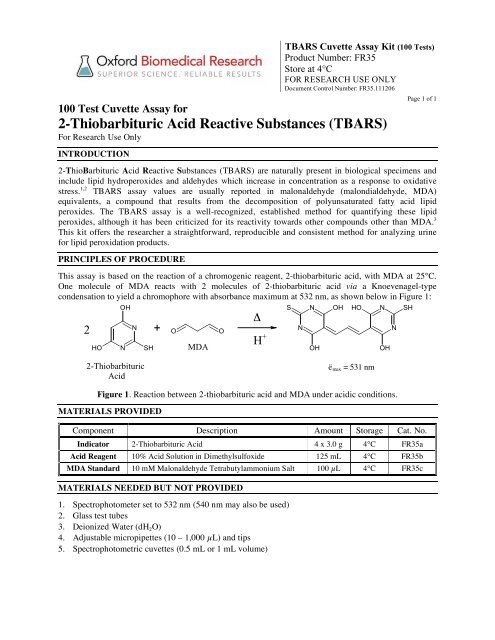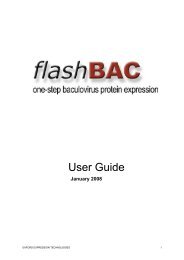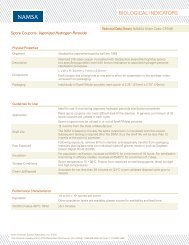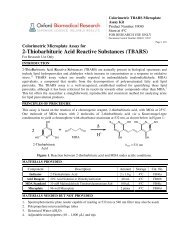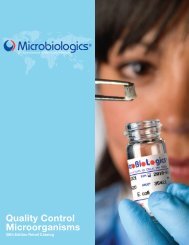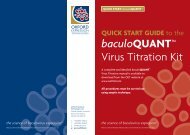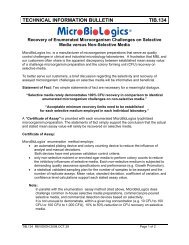2-Thiobarbituric Acid Reactive Substances (TBARS) - BioNovus Life ...
2-Thiobarbituric Acid Reactive Substances (TBARS) - BioNovus Life ...
2-Thiobarbituric Acid Reactive Substances (TBARS) - BioNovus Life ...
Create successful ePaper yourself
Turn your PDF publications into a flip-book with our unique Google optimized e-Paper software.
<strong>TBARS</strong> Cuvette Assay Kit (100 Tests)Product Number: FR35Store at 4°CFOR RESEARCH USE ONLYDocument Control Number: FR35.111206100 Test Cuvette Assay for2-<strong>Thiobarbituric</strong> <strong>Acid</strong> <strong>Reactive</strong> <strong>Substances</strong> (<strong>TBARS</strong>)For Research Use OnlyINTRODUCTIONPage 1 of 12-ThioBarbituric <strong>Acid</strong> <strong>Reactive</strong> <strong>Substances</strong> (<strong>TBARS</strong>) are naturally present in biological specimens andinclude lipid hydroperoxides and aldehydes which increase in concentration as a response to oxidativestress. 1,2 <strong>TBARS</strong> assay values are usually reported in malonaldehyde (malondialdehyde, MDA)equivalents, a compound that results from the decomposition of polyunsaturated fatty acid lipidperoxides. The <strong>TBARS</strong> assay is a well-recognized, established method for quantifying these lipidperoxides, although it has been criticized for its reactivity towards other compounds other than MDA. 3This kit offers the researcher a straightforward, reproducible and consistent method for analyzing urinefor lipid peroxidation products.PRINCIPLES OF PROCEDUREThis assay is based on the reaction of a chromogenic reagent, 2-thiobarbituric acid, with MDA at 25°C.One molecule of MDA reacts with 2 molecules of 2-thiobarbituric acid via a Knoevenagel-typecondensation to yield a chromophore with absorbance maximum at 532 nm, as shown below in Figure 1:2HOOHNNSH+OMDAOH +SNNOHOHHONOHNSH2-<strong>Thiobarbituric</strong><strong>Acid</strong>ë max = 531 nmFigure 1. Reaction between 2-thiobarbituric acid and MDA under acidic conditions.MATERIALS PROVIDEDComponent Description Amount Storage Cat. No.Indicator 2-<strong>Thiobarbituric</strong> <strong>Acid</strong> 4 x 3.0 g 4°C FR35a<strong>Acid</strong> Reagent 10% <strong>Acid</strong> Solution in Dimethylsulfoxide 125 mL 4°C FR35bMDA Standard 10 mM Malonaldehyde Tetrabutylammonium Salt 100 μL 4°C FR35cMATERIALS NEEDED BUT NOT PROVIDED1. Spectrophotometer set to 532 nm (540 nm may also be used)2. Glass test tubes3. Deionized Water (dH 2 O)4. Adjustable micropipettes (10 – 1,000 μL) and tips5. Spectrophotometric cuvettes (0.5 mL or 1 mL volume)
FR35.111206 Oxford Biomedical Research Inc., 2011 Page 3 of 3SAMPLE PREPARATIONWhen working with plasma, the sample should be deproteinated with an acid. Centrifuge and use thesupernatant to perform the assay. This solution may appear cloudy after the reaction, and can be clarifiedby passing through a 0.2 μ syringe filter.When working with urine, colored compounds contribute to the signal measured at 532 nm. Thisinterference can be removed by running a sample blank with each sample.Urine1. Urine samples can be used directly and should be assayed immediately. If the assay is to beperformed on a different day, the sample should be stored at -70°C.Plasma1. Collect blood with an additive such as heparin, EDTA or citrate to prevent coagulation.2. Centrifuge the sample for 10 minutes at 2000 g at 4°C.3. Carefully remove the straw-colored plasma layer and store on ice for use on the same day, or at-70°C for up to thirty days.4. Plasma samples can be run without dilution.Serum1. Collect whole blood without the addition of any additives, such as an anticoagulant.2. At room temperature, allow the blood to clot for 30 minutes.3. Centrifuge the sample at 2,000 g for 15 minutes at 4°C.4. Carefully remove the straw-colored serum layer and store on ice for use on the same day, or at-70°C for up to thirty days.5. Serum samples can be run without dilution.STANDARD CURVE PREPARATIONMalondialdehyde is provided as a solution of the malondialdehyde tetrabutylammonium (MDA-TBA) saltin a slightly basic buffer because MDA itself is not stable. When mixed with the acidic Indicator Solution,the MDA-TBA molecule is acidified and generates MDA quantitatively.Please see the Reagent Preparation section for preparing the 20 μM MDA Standard Stock.Table 1: Colorimetric Standard Curve PreparationStandardMDA Conc.(μM)Vol. of dH 2 O(μL)Vol. of 20 μM MDAStock (μL)S0 0 1000 -S1 0.5 975 25S2 1.0 950 50S3 2.5 875 125S4 5.0 750 250S5 10.0 500 500S6 15.0 250 750S7 20.0 - 1000


